Great French Destinations: Raise a Glass to Gironde
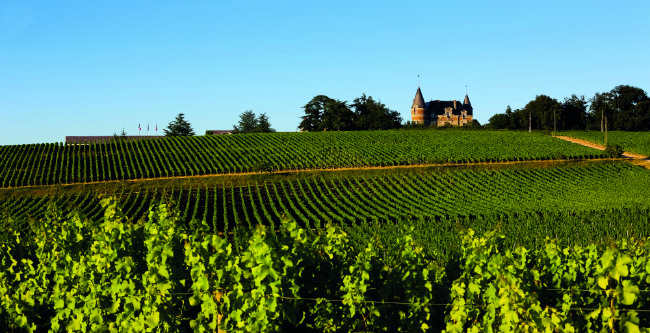

Rolling vineyards and alluring wine routes, oodles of gorgeous châteaux and a coastline steeped in history – this is a corker of a region. Gill Harris reveals just why you should pay it a visit
There’s a patch of fog that rises every evening and burns off late morning, as the sun heats the earth just where the Ciron and Garonne rivers meet. It brings a dampness with it which, for many, would mar the summer mornings.
But for the people who live in the area, it is something magical. For it is here that noble rot, born out of this very particular combination of dampness and warmth, sets to work ‘raisining’ the grapes in the vineyards to produce a sweet, heady flavour; and it is these grapes – Sauvignon Blanc, Sémillon and Muscadelle – that form the world-famous Sauternes.
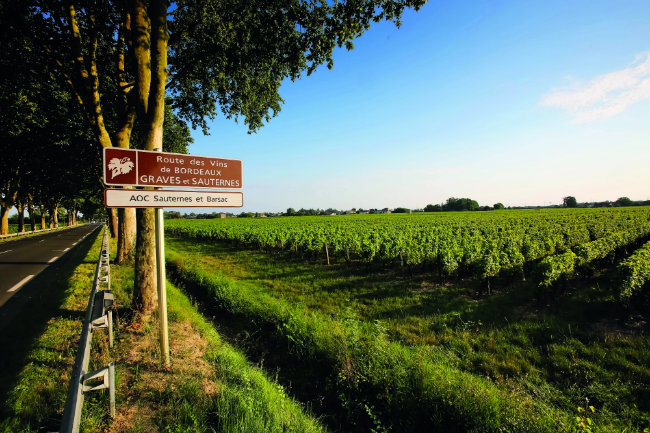
The Route des Vins de Bordeaux. Photo: www.bordeaux-graves-sauternes.com
The fog rises because the Ciron is colder than the Garonne and when they meet, a mist is produced. A short distance up or down the river and the effect is lost. A cooler climate and the dampness would linger too long, resulting in grey rot and ruined grapes.
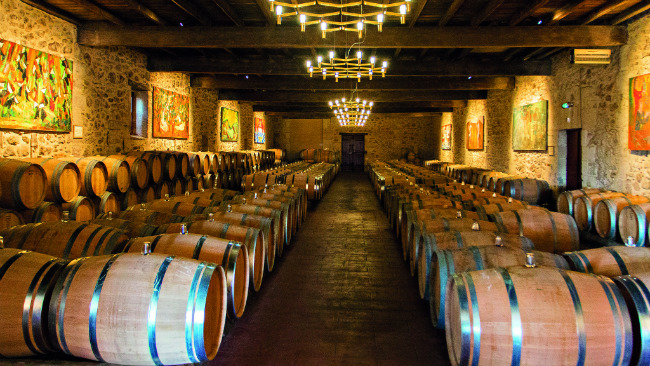
Wine is aged in French oak barrels in the wine cellar at Château Sigalas-Rabaud for at least 18 months
But this unique micro-climate produces just the right sort of rot. “They look horrible, disgusting. But I tasted them, and they taste… ah! Delicious,” says Laure de Lambert Compeyrot, owner of Château Sigalas-Rabaud, first Grand Clu Classé of Sauternes in 1855.
Having turned her back on a career as a lawyer to return to the family estate, the smallest of the Cru Classé of Sauternes, Laure’s passion for her art is clear to see. She is dedicated to pushing her wine to the limits, experimenting with different blends and alternative methods.
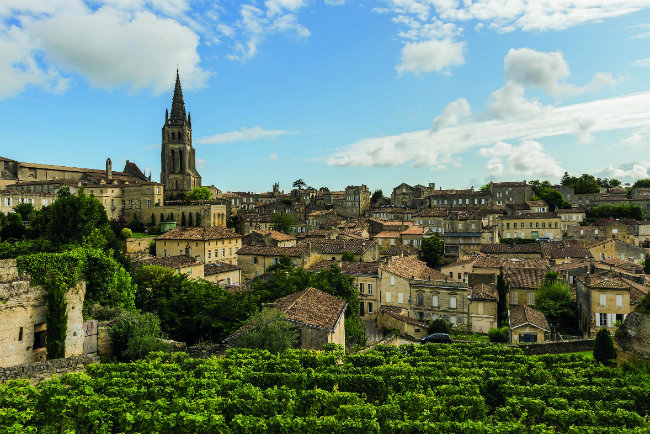
Saint-Émilion’s monolithic church dates from the 12th century. Photo: Fotolia
DOWN TO A FINE ART
She is not alone. Everyone I meet during my time in Gironde reminds me that wine is a thing of wonder: from the exact nature of the soil (clay, limestone, gravel) to the amount of wind a particular slope is subjected to, to when and which grapes are picked (by hand, no less), to how much fire the oak barrels have been exposed to. Every element of wine production makes it clear that this is an art.
But Sauternes is merely one small part – just five villages in about 23 square miles – of Gironde, the département that is home to Bordeaux, one of the most famous wine regions in the world.
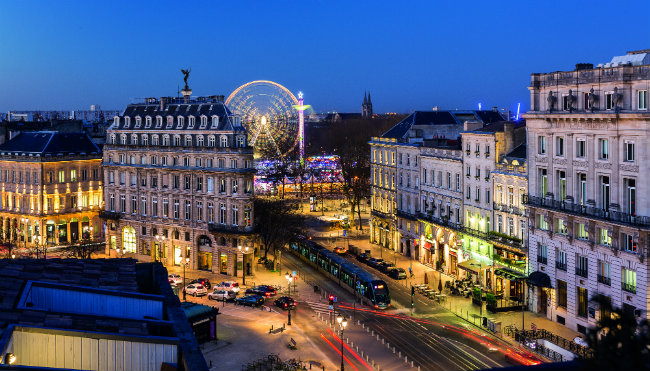
Bordeaux at night. Photo: Steve Le Clech Photos
The area is cut through by the mighty Garonne and Dordogne rivers. South of the city of Bordeaux, you have the flat, horizon-sweeping Médoc region, with its flurry of grand châteaux. Between the rivers lies the hillier area of Entre-Deux-Mers and, over in Saint-Émilion, you can admire the unique, sweeping combes. The Atlantic coast brings a different flavour, with its fantastic surfing beaches and historic sites.

The Porte Dijeaux in shoppers’ paradise in Bordeaux. Photo: Nicolas Duffaure
Bordeaux’s long history of wine production dates back to the eighth century. It found popularity among the English when Eleanor of Aquitaine married Henry II of England, putting Bordeaux under English rule from the late 12th century until the middle of the 15th.
Busy trading routes were established along the fiercely guarded Garonne. There was clearly money to be had from this land and, to this day, the riches are clear to see. The countryside, a vast carpet of vines, is dotted with château after château, grand houses dating back to the 16th and 17th centuries. Many of them have remained in the same family for generations.
We drive along the D2, the Route des Châteaux, in Médoc, and marvel at each fairytale pile before arriving at the majestic Château Pédesclaux in Pauillac, where old – rather stunningly – meets new.
The original building dates back to 1810, sitting at the centre of 50 hectares. But what is magnificent about this place is its transformation at the hands of architect Jean-Michel Wilmotte, who has added a modern twist: using glass, steel, concrete and oak in honour of the winemaking process and the surrounding land.
This forward-thinking château, like many others in the region, is focused on organic, biodynamic production. The message is clear: it is the land that produces the wine, so we must look after that land. For example, Petit Verdot didn’t get on so well in this area, my guide tells me, but now it is flourishing – thanks to global warming.
And it is that simple – despite the richness of the soil and the dedication of the winegrowers, life can still be tough, as everything here is very much at the mercy of the weather.
There is one date etched on every Bordelais’s memory: April 28, 2017.
A brutally late frost descended on the area, destroying crops wherever it fell. Some were lucky, and lost only a small portion of their yield. Others, like the 8.5-hectare Château Vénus, further south in Graves, lost 80 per cent.
A BIRD’S-EYE VIEW
Owners Bertrand and Emmanuelle Amart are surprisingly philosophical. “It happens,” they agree, smiling. Luckily for them, they have another string to their bow – offering tourists an aerial view of the area. Having learned to fly four years ago, Bertrand pilots a small plane, treating visitors to breathtaking views of the whole region. On a clear day, he tells me, you can see as far as the Pyrénées, beyond the 10,000-square- kilometre Landes Forest.
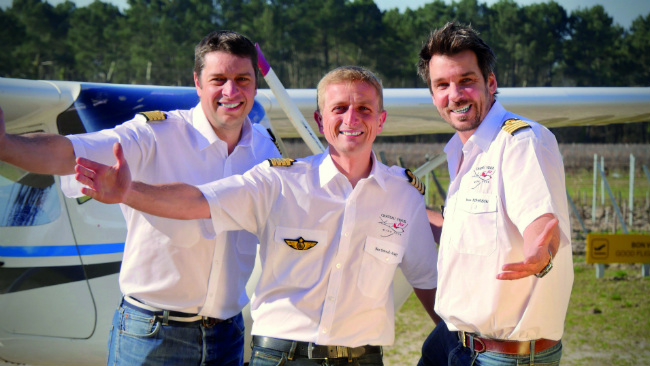
Bertrand (centre) and other pilots at the Château Vénus.
“Today is a good day to fly,” he declares, as I’m buckled into the tiny plane. “On a summer day, it is just like being in a car, but today we have wind – so it will really be like flying.”
He isn’t wrong, but as I cling on while the plane is buffeted by heavy winds and approaching storms, I cannot help but marvel at the beauty of the landscape below us.
The couple are not the only winegrowers who are expanding their repertoire in order to keep tourists entertained.
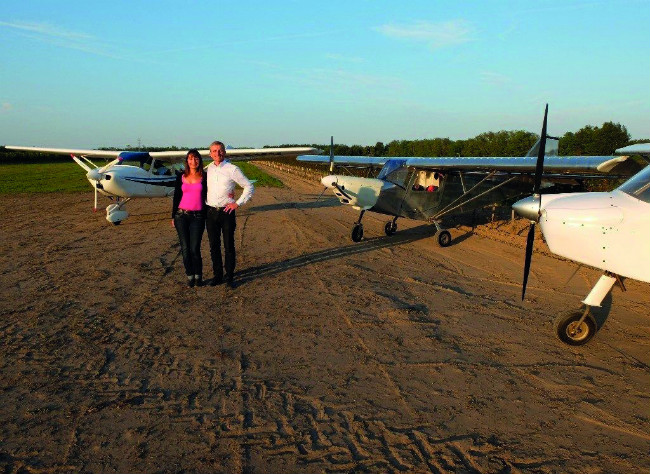
Emmanuelle and Bertrand Amart of Château Vénus with one of the planes
If you find yourself in Bordeaux, a visit to the vineyards, a chat with a château owner about the artistry of producing wine and that heady whiff of a cellar packed with the finest French oak barrels, not to mention a dégustation (of course!) is de rigueur – even if you are not a wine buff.
My guide, Johanna, tells me that the tourist board has been working hard with châteaux to improve the visitor experience. The result is the wine route (La Route des Vins), which offers activities and information to help people discover the vineyards more easily.
Just outside the village of Saint-Émilion, Jean-Michel Bonnichon is eagerly awaiting us. He is keen to talk about his 12 hectares and the wine he lovingly produces. But he also wants to share his passion for something else – the Segway.
Another former lawyer, Jean-Michel loves nothing more than taking his guests on a Segway tour of Château la Renommée, a Saint-Émilion Grand Cru, and the surrounding areas.
Whizzing through the fields, we stop occasionally to examine the soil, admire the vines and learn a little about life as a winegrower.
BACK TO BASICS
Beside one path is a battered old stone hut with a metal ring inside to tether a bull, a small fireplace for cooking and just enough space for a bed. It is built under the shade of an acacia tree, and would have provided shelter for a labourer during periods of heavy work.
The tour is great fun and Jean-Michel is extremely knowledgeable. He will take people as far as the village of Saint-Émilion if they wish and cater for couples, families and even stag dos.
For sporty sorts, this region has plenty to offer – from surfing on the Atlantic coast to cycling through the pine forests.
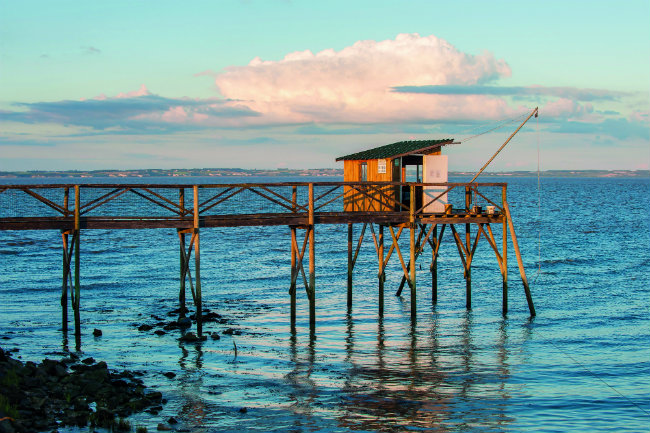
Fishing cabins on the Gironde Estuary. Photo: Vincent Bengold
If you like to experience the great outdoors at a rather more leisurely pace, there are boat trips on the Garonne, where you can take in the area’s natural beauty and wildlife. Watch out for the fishermen’s huts on stilts lining the banks: a flashback to a bygone era.
And if you’re lucky enough to be in the region for the tidal bore – Le Mascaret – you can even surf, or at least watch those who dare. One such enthusiast is Mathieu Verdier, who is also, of course, a winegrower. He has even named one of his wines after the tide – Le Mascaret.
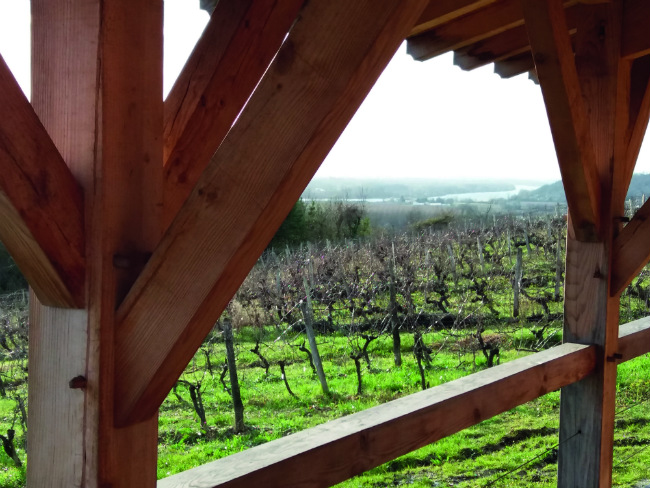
Look out over the vineyards from the cabin at Château Bessan while sampling the latest vintage
Mathieu is one of the young, dynamic winegrowers of the region, having moved to Château Bessan in Tabanac with his family as a child in the 1980s. Here he has created the Cabin in the Vines, overlooking the beautiful vineyards and the mighty Garonne beyond. Like so many in the area, he is passionate about nature and preserving this unique, rich land for coming generations. The cabin, where you can sit on the veranda and enjoy a glass of the estate’s fine wine – or delicious grape juice if you prefer, is powered completely by wind and sun and was built by hand by Mathieu himself.
HEAD OVER HEELS
It is easy to see why the Bordelais are so in love with their land. Not only does it produce some of the best wines in the world, but its varied landscape offers something for everyone, from the hills to the forests to the beaches – and one particularly impressive phenomenon.
The Grande Dune du Pilat is the tallest sand dune in Europe and can be found in Arcachon Bay, 60 kilometres southwest of Bordeaux. It can be climbed all year round – and is by millions, although in summer wooden steps make the ascent a little easier.
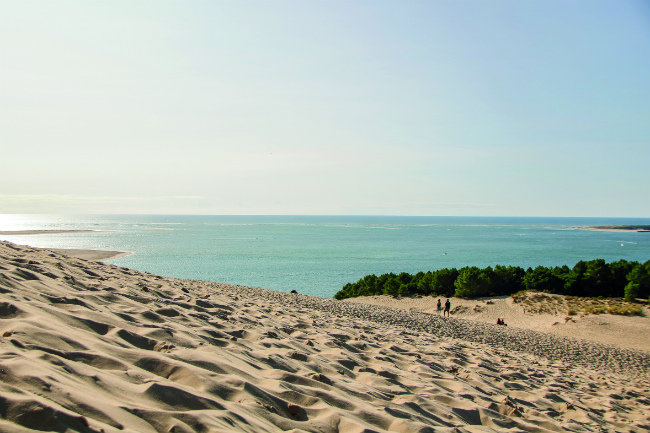
Dune du Pilat. Photo: Fotolia
This massive dune lies near the charming coastal town of Arcachon, an elegant seaside resort that was dramatically transformed from a shabby settlement for the poor to a fashionable destination in the 1850s, when it gained a reputation for being the place to go if you wanted to recover from tuberculosis.
Arcachon’s location on a sheltered bay, surrounded by pine forests, made it the ideal location for an outdoor sanatorium, or so they thought, and even the likes of Queen Victoria’s granddaughter, Louisa, were sent there to recuperate. It is known as the Town of Four Seasons, boasting Spring, Summer, Autumn and Winter Town. The latter was where the wealthy visitors came with their families to be cured of tuberculosis, resulting in magnificent villas along winding tree-lined streets. There’s even an Anglican church here, a lonely outpost of Protestantism in this Catholic region.
Today, after being largely abandoned between the Second World War and the 1970s, these properties are worth millions, and many have been split into apartments for holiday lets. It is gloriously beautiful and well worth a visit – you will feel you have stepped back in time to a grander era.
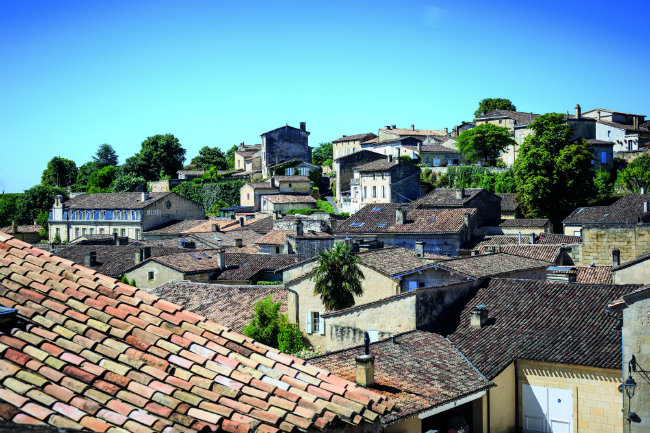
Saint-Émilion was said to have been settled by the Romans 2,000 years ago
If history is your passion, head 45 minutes to the east of Bordeaux to the picturesque medieval town of Saint-Émilion, with its higgledy-piggledy houses, shady squares and magnificent underground church. This small commune, with a population of 2,000, welcomes more than one million visitors a year – and it’s easy to see what the attraction is.
Beginning its story with the Romans who planted vines here in the 2nd century AD, it takes its name from the monk Émilion, who carved his hermitage into a rock here in the 8th century. The town is steeped in history, from its underground passages and catacombs to its narrow streets, lined with giant cobbles made of stone brought over from England to ballast the unloaded returning wine ships.
Another must for history fans in this land of châteaux, is a real castle – Château de Roquetaillade. There are ruins of the original 12th-century building alongside the stunning 14th-century castle, which underwent a dramatic transformation in the 19th century, thanks to the legendary Viollet-le-Duc.
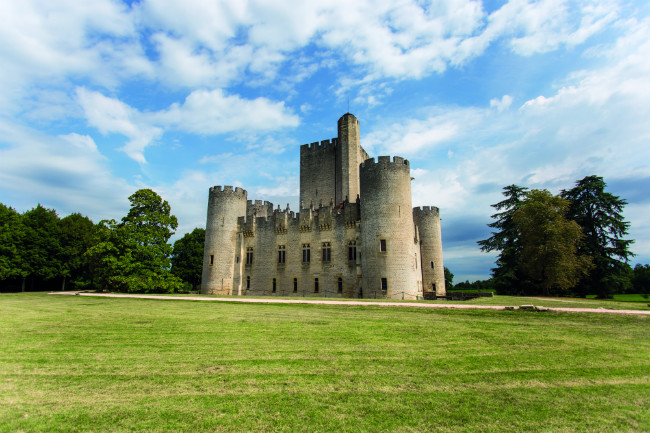
The 14th-century Château de Roquetaillade is named after the caves beneath it
A THING OF BEAUTY
The owners love nothing more than to give visitors a guided tour, showing off the spectacular interior design with its over-the-top replaces and beautifully carved finishings, as well as a rather dramatic hidden drawbridge leading from the dining room, over the moat and into the castle grounds.
Of course, no visit to Gironde would be complete without a tour of the city of Bordeaux itself, which is a UNESCO World Heritage Site. Again, old meets new in this remarkable place, with the cobbled winding streets of the medieval old town; the grand, imposing squares of the 17th and 18th centuries; and, freshly uncorked and a source of much pride, La Cité Du Vin wine museum.
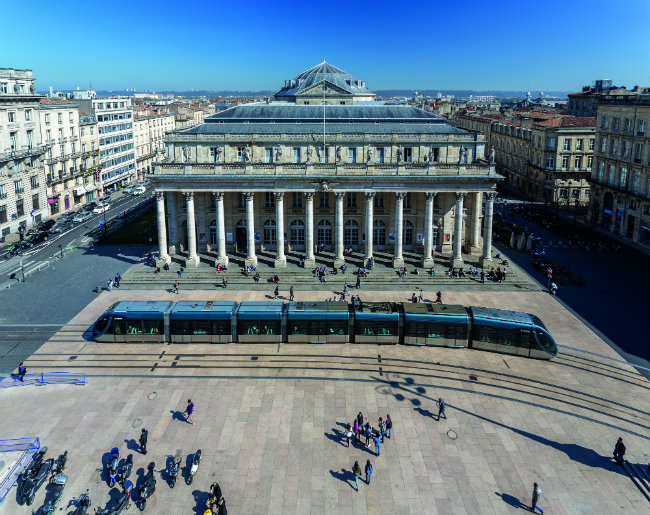
The Grand Théâtre is one of the city’s best-loved landmarks. Photo: Steve Le Clech Photos
Bordeaux is the sixth largest city in France and is considered the wine capital of the world, taking in about €14.5 billion a year from the industry. It can trace its roots back to the Romans, but it is the glory years of the wine trade and its reliance on the magnificent Garonne that have given this metropolis its majesty.
Voted the best city in the world to visit by Lonely Planet in 2017, it is worth booking a history tour with the tourist office to fully appreciate the architecture and the stories behind the handsome streets of Bordeaux. Admire the breathtaking grandeur of the Grand Théâtre – the inspiration for the Paris Opera House – and the Place de la Bourse, and wander the streets of Saint Pierre with its beautiful squares, outdoor cafés and winding streets. And don’t forget to look up and spot the famous Bordeaux mascarons – carved stone faces that adorn the buildings.
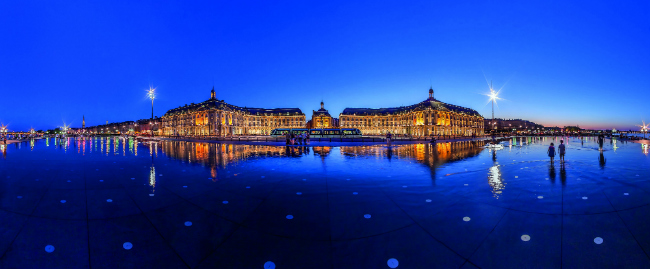
The Miroir d’eau. Photo: Vent d’Autan – C. Bouthé
As my trip comes to a close, I stand at the riverside – my back to the Place de la Bourse – and gaze at the water mirror, designed to reflect the magnificent façades of the surrounding buildings, and find myself reflecting on Gironde.
Like the wine for which it is so famous, the region is exquisite and well balanced, with something for everyone, from the misty shores of Sauternes to the ancient town of Saint-Émilion, and from wine cellars to surfing. And one thing is for sure: it certainly lingers on the palate.
From France Today magazine
Share to: Facebook Twitter LinkedIn Email
By Gill Harris
Leave a reply
Your email address will not be published. Required fields are marked *




REPLY